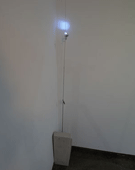Artist Julianne Swartz's work helps the physical impulses of the human body circumvent forces that confine and structure them. She crafts devices from delicate-looking materials--elaborate periscopes and baroque series of sound-carrying tubes--that both enhance sensory faculties and also formally mimic the fragile structures of the human body. The artist's perception-augmenting installations have tended to play off existing architecture to subvert conventional experiences of space by offering rival modalities. Slightly shifting her stance, Swartz's new body of work, on view at New York's Josee Bienvenu gallery through June 29, articulates a relationship of similarity between physical sensations and passing time. In a series of eight kinetic sculptures, wisps of steel wire stand above blocks of cement. Attached to clock motors, the wires writhe or sway with each passing second. Some carry small LEDs, while others incorporate hanging snippets of text, but they all instantiate time with a delicate physicality. Resembling weeds growing up from their inert brutalist bases, the series forgoes the dispassionate hands of a clock and measures seconds in figurative gestures that evoke human fragility in the face of passing time. They highlight the strongest element in all Swartz's work, which is the way it draws attention to technology's ability to shape alternative--and radically humanized--experiences of the world. - Bill Hanley
